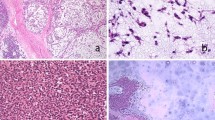Summary
Ultrastructural studies of 11 human breast carcinomata revealed that most stromal cells could be arranged in a cell spectrum from fibroblasts, with abundant rough endoplasmic reticulum, to myofibroblasts. In 4 out of 11 cases, myoepithelial cells were observed in the parenchyma at the periphery of some carcinomatous duct-like structures or carcinoma cell nests. The distinction between myofibroblasts and myoepithelial cells was usually easy from their respective locations. Their ultrastructural features were summarized as follows. Myofibroblasts: (1) abundance of rough ER and other cytoplasmic organelles; (2) bundles of microfilaments, 50–70 Å in diameter and associated dense bodies. Myoepithelial cells: (1) bundles of microfilaments 50–70 Å in diameter and associated dense bodies (a common feature); (2) dense bundles of tonofilaments, 80–100 Å in diameter; (3) typical desmosomes which connected them with adjacent myoepithelial or carcinoma cells. Myofibroblasts were occasionally located closely contiguous with carcinoma cells, giving an appearance resembling myoepithelial cells. Even in these instances a distinction between myofibroblasts and myoepithelial cells was possible, since myoepithelial cells had dense bundles of tonofilaments and typical desmosomes, which were not observed in myofibroblasts. No cell types intermediate between myofibroblasts and myoepithelial cells were detected. We could not decide whether myoepithelial cells were neoplastic or not despite the facts that they showed obscured polarity and had partially or completely lost their basal lamina. We conclude that fibroblasts, myofibroblasts and probably some, if not all, smooth muscle cells belong to the same cell system. Myofibroblasts in our material are derived from fibroblasts, while myoepithelial cells are epithelial in origin.
Similar content being viewed by others
References
Ahmed, A.: The myoepithelium in human breast carcinoma. J. Pathol. 113, 129–135 (1974)
Ahmed, A.: Atlas of the ultrastructure of human breast diseases, pp. 88–89. Edinburgh: Churchill Livingstone Co. 1978
Bhawan, J., Bacchetta, C., Joris, I., Majno, G.: A myofibroblastic tumor. Infantile digital fibroma (Recurrent digital fibrous tumor of childhood). Am. J. Pathol. 94, 19–36 (1979)
Bloom, W., Fawcett, D.W.: A textbook of histology, 10th edition, pp. 171–172. Philadelphia: Saunders Co. 1975
Clarke, M., Spudich, J.A.: Nonmuscle contractile proteins: The role of actin and myosin in cell motility and shape determination. Ann. Rev. Biochem. 46, 797–822 (1977)
Fisher, E.R.: Ultrastructure of the human breast and its disorders. Am. J. Clin. Pathol. 66, 291–375 (1976)
Gabbiani, G., Majno, G.: Dupuytren's contracture: fibroblast contraction? An ultrastructural study. Am. J. Pathol. 66, 131–146 (1972)
Gabbiani, G., Hirschel, B.J., Ryan, G.B., Statkov, P.R., Majno, G.: Granulation tissue as a contractile organ. A study of structure and function. J. Exp. Med. 135, 719–734 (1972)
Goldenberg, V.E., Goldenberg, N.S., Sommers, S.C.: Comparative ultrastructure of atypical ductal hyperplasia, intraductal carcinoma, and infiltrating ductal carcinoma of the breast. Cancer 24, 1152–1169 (1969)
Goldman, R.D.: The use of heavy meromyosin binding as an ultrastructural cytochemical method for localizing and determining the possible functions of actin-like microfilaments in nonmuscle cells. J. Histochem. Cytochem. 23, 529–542 (1975)
Gould, V.E., Miller, J., Jao, W.: Ultrastructure of medullary, intraductal, tubular and adenocystic breast carcinomas. Comparative patterns of myoepithelial differentiation and basal lamina deposition. Am. J. Pathol. 78, 401–416 (1975)
Hamperl, H.: The myothelia (myoepithelial cells). Normal state; regressive changes; hyperplasia; tumor. Curr. Top. Pathol. 53, 161–220 (1970)
Majno, G., Gabbiani, G., Hirschel, B.J. Ryan, G.B., Statkov, P.R.: Contraction of granulation tissue in vitro: Similarity to smooth muscle. Science 173, 548–550 (1971)
McLean, M.J., Pelleg, A., Sperelakis, N.: Electrophysiological recordings from spontaneously contracting reaggregates of cultured smooth muscle cells from guinea pig vas deferens. J. Cell Biol. 80, 539–552 (1979)
McNutt, N.S., Weinstein, R.S.: Membrane ultrastructure at mammalian intercellular junctions. Progr. Biphys. Mol. Biol. 26, 47–101 (1973)
Murad, T.M., Haam, E.: Ultrastructure of myoepithelial cells in human mammary gland tumors. Cancer 21, 1137–1149 (1968)
Ohtani, H., Sasano, N.: Myofibroblasts in human breast carcinoma. An ultrastructure study. Tohoku J. Exp. Med. 128, 123–137 (1979)
Ozzello, L.: Epithelial-stromal junction of normal and dysplastic mammary glands. Cancer 25, 586–600 (1970)
Ozzello, L.: Ultrastructure of the human mammary gland. Pathol. Ann. 6, 1–59 (1971)
Ross, R., Klebanoff, S.J.: The smooth muscle cell. I. In vivo synthesis of connective tissue proteins. J. Cell Biol. 50, 159–171 (1971a)
Ross, R.: The smooth muscle cell. II. Growth of smooth muscle in culture and formation of elastic fibers. J. Cell Biol. 50, 172–186 (1971b)
Ryan, G.B., Cliff, W.J., Gabbiani, G., Irlé, C., Statkov, P.R., Majno, G.: Myofibroblasts in an avascular fibrous tissue. Lab. Invest. 29, 197–206 (1973)
Ryan, G.B., Cliff, W.J., Gabbiani, G., Irlé, C., Montandon, D. Statkov, P.R., Majno, G.: Myofibroblasts in human granulation tissue. Hum. Pathol. 5, 55–67 (1974)
Schäfer, A., Bässler, R.: Vergleichende elektronenmikroskopische Untersuchungen am Drüsenepithel und am sog. lobulären Carcinom der Mamma. Virchows Arch. Abt. A Path. Anat. 346, 269–286 (1969)
Stirling J.W., Chandler, J.A.: The fine structure of the normal, resting terminal ductal-lobular unit of the female breast. Virchows Arch. A Path. Anat. and Histol. 372, 205–226 (1976)
Sykes, J.A., Recher, L., Jernstrom, P.H., Whitescarver, J.: Morphological investigation of human breast cancer. J. Nat. Cancer Inst. 40, 195–223 (1968)
Tannenbaum, M., Weiss, M., Marx, A.J.: Ultrastructure of the human mammary ductule. Cancer 23, 958–978 (1969)
Vasudev, K.S., Harris, M.: A sarcoma of myofibroblasts. An ultrastructural study. Arch. Pathol. Lab. Med. 102, 185–188 (1978)
Wessells, N.K., Spooner, B.S., Ash, J.F., Bradley, M.O., Luduena, M.A., Taylor, E.L., Wrenn, J.T., Yamada, K.M.: Microfilaments in cellular and developmental processes. Science 171, 135–143 (1971)
Wirman, J.A.: Nodular fasciitis, A lesion of myofibroblast. An ultrastructural study. Cancer 38, 2378–2389 (1976)
Author information
Authors and Affiliations
Additional information
Supported in part by Public Health Service Contract No. 1CP23213 from National Cancer Institute, U.S.A. and by a Grant-in-Aid for Cancer Research No. 51-7 from the Ministry of Health and Welfare, Japan
Rights and permissions
About this article
Cite this article
Ohtani, H., Sasano, N. Myofibroblasts and myoepithelial cells in human breast carcinoma. Virchows Arch. A Path. Anat. and Histol. 385, 247–261 (1980). https://doi.org/10.1007/BF00432535
Received:
Issue Date:
DOI: https://doi.org/10.1007/BF00432535




